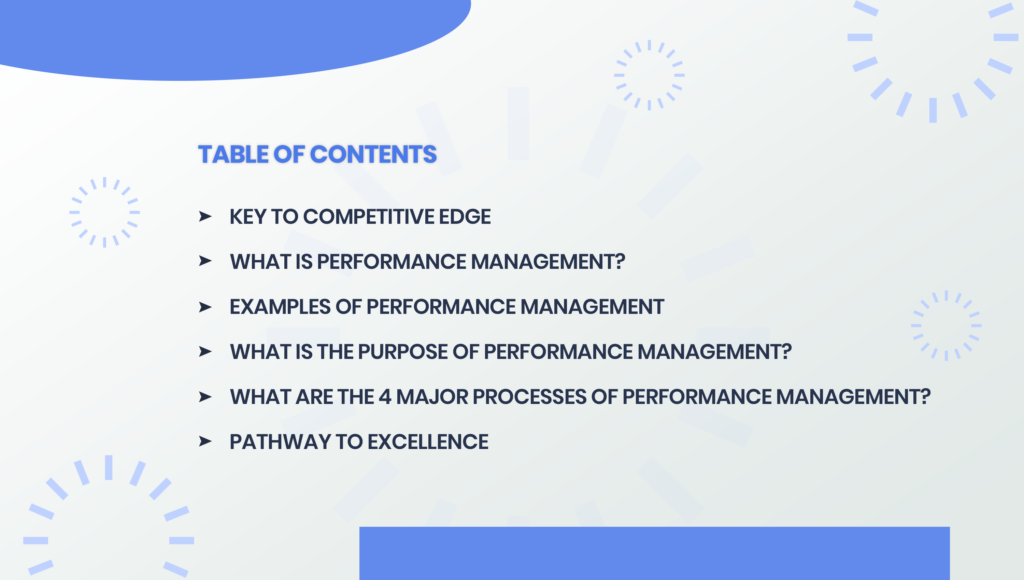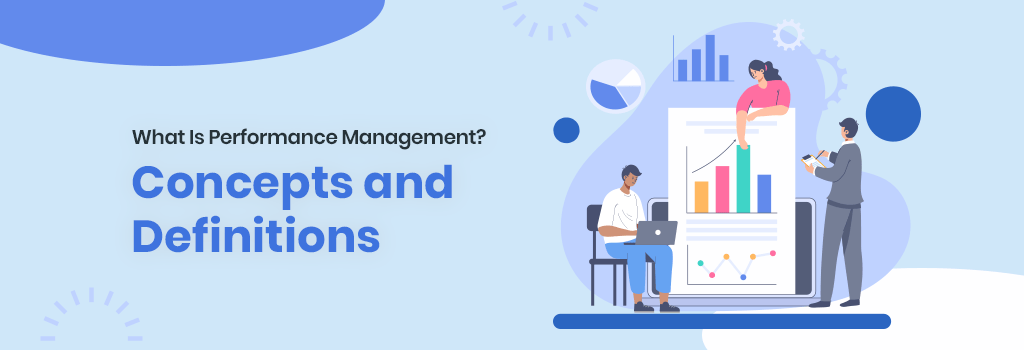Performance management is a systematic approach aimed at enhancing an organization’s overall performance by ensuring that employees work effectively and efficiently to achieve common goals.

KEY TO COMPETITIVE EDGE
In today’s fast-paced and competitive business landscape, performance management is essential not only for the survival but for the flourishing of companies.
At its core, performance management is a continuous and systematic process aimed at enhancing the effectiveness of employees, aligning their individual objectives with the overarching goals of the organization. It achieves this through meticulous goal setting and the astute use of metrics, providing a clear gauge of progress and identifying areas of individual proficiency.
Performance management aspires to instill a culture wherein both individuals and teams assume accountability for perpetually enhancing business operations, refining their skills, and amplifying their contributions. The contemporary significance of performance management lies in its capacity to elevate organizational performance by augmenting employee efficiency and recognizing that an organization’s true wealth resides in its intellectual capital—its people.
In this context, the success and competitiveness of any enterprise are intrinsically linked to the productivity and proficiency of its workforce, making performance management an indispensable aspect of organizational excellence.
WHAT IS PERFORMANCE MANAGEMENT?
Performance management is a continuous process where managers and employees work together to plan, monitor and review an employee’s work objectives and the overall contribution to the organization.
Performance management stands as a strategic imperative in today’s dynamic world, empowering employees to excel and align their efforts with organizational goals.
Performance management encompasses a set of systematic processes and practices designed to improve organizational efficiency, enhance employee productivity, and align individual and team performance with strategic objectives.
At its core, performance management is about setting clear expectations, providing regular feedback, and fostering a culture of continuous improvement. It is a dynamic and ongoing process that involves defining goals, monitoring progress, identifying areas for development, and recognizing achievements.
By doing so, performance management enables organizations to adapt to changing circumstances, identify areas for improvement, and leverage their strengths to achieve success.
In this comprehensive guide, we will explore key components, key benefits of performance management, and performance management best practices where it will help you grasp the fundamental principles and practices to enhance your organization’s performance.
EXAMPLES OF PERFORMANCE MANAGEMENT
Here, we delve into a few concrete examples that vividly illustrate the essence of performance management that encompasses a range of strategies and tools designed to enhance workforce productivity and ensure that individual performance aligns with organizational goals.
These examples underscore the depth and breadth of performance management, which is a dynamic and integrated approach aimed at optimizing workforce productivity while ensuring that everyone’s efforts contribute harmoniously to the organization’s overarching goals.
1. Employee Goal Setting
Performance management often begins by setting clear and achievable goals for employees. This fundamental aspect of performance management ensures that every member of the organization is aware of their role and responsibilities. These goals are aligned with the organization’s objectives, providing employees with a roadmap of what is expected of them.
Through collaborative discussions, employees establish clear and achievable goal, when they are aligned with the organization’s strategic objectives. As a result, employees have a roadmap that not only guides their actions but also ensures they contribute meaningfully to the overarching mission.
2. Regular Performance Reviews
In the realm of performance management, regular performance reviews are akin to checkpoints on a journey. Managers conduct periodic performance reviews to assess an employee’s progress towards their goals. These reviews serve as a platform for constructive feedback, open discussion, and identifying areas for improvement.
These structured evaluations provide a platform for employees and managers to discuss progress toward their goals. They serve as an opportunity for constructive feedback, allowing employees to understand where they excel and where improvements are needed. The feedback loop established through regular reviews enables continuous learning and adaptation.
3. 360-Degree Feedback
Going beyond the traditional top-down approach, performance management can also involve gathering feedback from various perspectives. This comprehensive view offers a well-rounded evaluation of an employee’s performance that includes 360-degree feedback from peers and subordinates.
The 360-degree feedback process provides a holistic evaluation of an employee’s performance, helping to identify strengths and areas for growth. This inclusive approach to feedback ensures a well-rounded understanding of an individual’s contributions.
4. Recognition and Rewards
Performance management isn’t solely about addressing shortcomings; it also focuses on recognizing and rewarding exceptional performance. Acknowledging and celebrating employees who consistently excel in their roles is vital for motivation and engagement. Recognition can take various forms, including bonuses, promotions, or non-monetary incentives like additional responsibilities.
WHAT IS THE PURPOSE OF PERFORMANCE MANAGEMENT?
Performance Management’s vital process serves several key purposes:
1. Improving Employee Performance
At its core, performance management is a vehicle for enhancing employee performance. It doesn’t just lay out expectations; it crafts them in crystal clarity which is designed to help employees perform at their best. It’s a process that empowers employees to be the best they can be.
By doing so, it equips employees with a precise roadmap to excel in their roles. It establishes clear expectations, provides regular feedback, and supports individuals in achieving their goals. The continuous feedback loop ensures employees are not left in the dark about their progress. Instead, they receive regular guidance, enabling them to fine-tune their performance and achieve their set goals.
2. Driving Organizational Success
Ultimately, the purpose of performance management is to contribute to the overall success of the organization. Alignment with organizational objectives is crucial for achieving strategic targets, as it ensures that all employees’ efforts are aligned with the company’s strategic vision.
3. Identifying Areas for Improvement
The true North of performance management is the organization’s success. Performance management ensures that every employee’s contribution, from the entry-level to the executive suite, resonates with the company’s strategic vision. It transforms abstract goals into tangible achievements.
It’s a well-orchestrated symphony where every instrument plays in harmony with the others. Through performance reviews and feedback mechanisms, areas needing improvement are identified. This allows for targeted interventions, such as training or development plans, to address weaknesses.
4. Supporting Employee Development
Every employee is a work in progress, and performance management acknowledges this by paving the way for personalized development plans. These plans are crafted based on the individual’s strengths and weaknesses, tailored to nurture talent and prepare employees for future roles.
It’s a dynamic process that recognizes the potential within each employee and provides them with the tools to continuously evolve and grow. By identifying strengths and weaknesses, performance management enables the design of personalized development plans. This aids in nurturing talent and preparing employees for future roles.
5. Enhancing Employee Engagement
Engagement is the lifeblood of any organization, and performance management serves as a catalyst for fostering it. When employees see their contributions recognized and rewarded, it ignites their motivation and commitment.
Recognition, whether in the form of financial incentives, promotions, or even a simple “thank you,” is a powerful driver of engagement. It’s a cycle where engaged employees become motivated contributors, thereby fueling the organization’s success.
WHAT ARE THE 4 MAJOR PROCESSES OF PERFORMANCE MANAGEMENT?
The performance management process comprises four critical steps, each holding its significance, regardless of the frequency of employee performance evaluations.
1. Plan – Setting the Stage for Success
The initial phase of performance management involves laying a solid foundation for employee success. The performance management journey begins with planning. During this phase, organizations establish clear performance expectations and goals for their employees. These goals adhere to the SMART criteria, ensuring they are Specific, Measurable, Achievable, Relevant, and Time-bound.
SMART objectives create a path for employees, outlining the route to success and fostering a sense of purpose. This clarity doesn’t just streamline individual efforts; it aligns them with the broader organizational mission. This meticulous planning equips employees with a well-defined roadmap towards success.
Key activities include:
- Goal Setting: Establishing individual and team goals aligned with the organization’s broader mission and objectives.
- Performance Standards: Defining objective criteria and benchmarks by which employee performance will be assessed.
- Development Plans: Identifying areas where employees may require training or mentorship to meet performance expectations.
2. Monitor – Real-time Tracking and Feedback
Once performance expectations are established, the monitoring phase comes into play. Organizations employ various tools and systems to keep a vigilant eye on employee performance against set goals and key performance indicators (KPIs).
The monitoring phase ensures that the journey stays on course. It provides real-time feedback, akin to the gentle nudges of a GPS, helping employees make timely course corrections and providing employees with valuable insights into their performance. This real-time tracking is the essence of staying agile in today’s rapidly changing world.
Key activities include:
- Ongoing Feedback: Providing regular and constructive feedback on employee performance, fostering continuous improvement.
- Performance Metrics: Using KPIs and metrics to objectively measure progress, enabling the identification of areas needing attention.
3. Review – Formal Evaluation and Reflection
The review phase is a structured dialogue where achievements are celebrated, challenges are acknowledged, and the path forward is charted. Managers and employees engage in a formal performance appraisal, discussing achievements, challenges, and potential areas for growth. These performance appraisals serve as a platform for constructive feedback, allowing for goal adjustments based on individual growth opportunities or evolving organizational priorities. It’s a phase of reflection and refinement.
Key activities include:
- Performance Appraisals: Conducting formal performance reviews to assess progress and discuss accomplishments and areas for improvement.
- Self-Assessment: Allowing employees to reflect on their performance, providing self-evaluation and insights into their development needs.
- Goal Adjustment: Based on the review, goals and expectations may be adjusted to better align with evolving business priorities or individual growth prospects.
4. Reward – Recognizing Excellence and Motivation
The final phase of performance management is about acknowledging and rewarding outstanding performance. This phase serves as a motivator and a morale booster – the beacon that motivates and inspires. It reinforces the connection between individual contributions and the overall success of the organization. It’s the fuel that keeps the journey alive and thriving.
Rewards come in various forms, including financial incentives such as bonuses or salary increases, promotions, or non-monetary acknowledgments. The reward system not only motivates high-performing employees but also reinforces the link between individual contributions and the organization’s overall success.
Key activities include:
- Recognition: Celebrating individual and team achievements, boosting morale, and fostering motivation.
- Compensation Adjustments: Providing financial incentives or salary adjustments to employees who have exceeded performance expectations.
- Career Development: Discussing potential career growth opportunities, including promotions or lateral moves that align with employees’ career aspirations.
PATHWAY TO EXCELLENCE
In an era where adaptability and efficiency reign supreme, performance management provides the blueprint for success, harmonizing individual aspirations with the broader objectives of the organization. Performance management is the dynamic engine that propels employees toward excellence while serving as the guiding beacon steering organizations toward their ultimate goals, instilling a sense of purpose and engagement throughout the workforce.
So, embark on this transformative journey of optimization, empower your employees, and chart a course toward excellence, unprecedented achievement and organizational brilliance with performance management as your unwavering guiding star.

